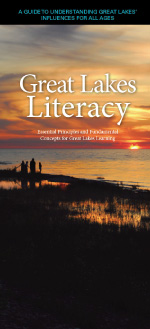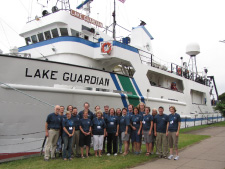A Loon’s Song for COSEE Great Lakes
COSEE Great Lakes is in its no-cost extension year, excited to bring to a crescendo the work we have done over five years in the COSEE Network with NSF/NOAA support. Our focus areas have been teacher education in the company of scientists, a key ingredient of the 2005 call for proposals that spawned our activities, and making the ocean sciences education world aware of the North Coast.
We’ve accomplished our work through the efforts of education leaders in the seven Sea Grant programs in the Great Lakes (GL) region, with half our funding provided by NOAA’s Office of Sea Grant and half by NSF. This partnership has enhanced what both sponsors could do! Programs were blended for greater outreach to Sea Grant’s state-based networks, and expanded to encompass national COSEE goals and opportunities. The whole has been greater than the sum of the parts!
Because of the efforts of COSEE GL (in no particular order):
| |  |
- The North Coast has Great Lakes Literacy Principles that parallel those of the ocean (thanks, COSEE CA!).
- Great Lakes Literacy Principles are in use in grade 4-16 classrooms to date; in a Great Lakes Discovery traveling exhibit from the Great Lakes Environmental Research Laboratory (GLERL); in numerous informal education programs in the region; and as guidance for the new GL B-WET program. They are illustrated by animations produced through the Cooperative Institute for Limnology and Ecosystems Research (CILER).
- NSF has found partners in NOAA and USEPA that support common goals for ocean sciences education.
- Concept mapping has been validated as an evaluation tool for extended workshops. Results indicate cognitive gain, increased conceptual development.
- A COSEE Collaborative has been nurtured on Lake Michigan.
- A regional Great Lakes Education Summit brought together leaders who synthesized COSEE GL contributions in collaboration, professional development, curriculum, informal education, and educational technology.
- 1300 educators and 190 scientists have engaged in professional development, addressing the needs of both groups as identified in baseline studies.
- A model for scientist professional development was implemented at two meetings of the International Association for Great Lakes Research.
- Two new sets of curriculum materials have been developed: Greatest of the Great Lakes and Fresh and Salt. These are free for use, found at coseegreatlakes.net.
- Four online workshops are archived with presentations and ancillary materials, on topics of: What’s so great about the Great Lakes?, Great Lakes ROCK!, and Great Lakes ALIVE, for subject matter enhancement, plus the plenary sessions by scientists and educators at the GL Education Summit.
- Weblogs chronicle the processes, topics and impacts of 16 weeklong workshops for educators.
- Communicating Ocean Science has been taught at the University of Michigan.
- A special issue of Science Activities journal was devoted to Ocean Literacy.
 | |
COSEE GL participants at the end of their shipboard research workshop, July 2011 | |
A highlight of this year has been the development of a partnership with USEPA’s Great Lakes National Program Office (GLNPO). COSEE evaluation demonstrated that educators who participated with scientists for a week on a shipboard science cruise not only learned a great deal of interdisciplinary science but also grew in their ability to make conceptual connections and identify opportunities for Great Lakes teaching. As a result, GLNPO has offered to support the shipboard workshop for an additional five years! Each year (five years, five lakes) the
R/V Lake Guardian will conduct its water quality monitoring program and accommodate other science projects while 15 educators are invited aboard for living and learning. (Watch this
video showing the highlights of an 8 day trip on Lake Superior with 15 teachers and several research scientists aboard the EPA's
R/V Lake Guardian).
This year’s voyage was on Lake Superior with Dr. Joel Hoffman as Chief Science Officer. Readers will learn more about Joel when he is featured in a case study of COSEE Scientists Making an Impact.
During the cruise, along with three other scientists from regional institutions, Joel engaged educators from six states and multiple disciplines in thinking about and studying firsthand the big picture of Lake Superior’s science. The grandeur of the environment and intensity of work combined for a realistic view of how ocean science and scientists work. Blogs about the experience tell the whole story from viewpoints of classroom educators, informal education and science.
It would be impossible to add more to these impressions. In many ways the words of participants in this single event capture what has been the best of COSEE GL:
Joel Hoffman. “When we have teachers working shoulder-to-shoulder with scientists, the teachers truly internalize the information, so they have the confidence to share it with others. And now they can share it with their students – the next generation of stewards of our Great Lakes.”
Teachers Sandy, Cindy and Lynn. “We each have found a strong desire to stay connected to the water and have developed a different kind of appreciation for the chemical, biological, and physical processes that are occurring there. This trip has truly fostered an appreciation and understanding of scientists as colleagues and resources. As we write this, concerns about our nation’s economic health continue to escalate. We hope that programs like this can continue to exist and that the important research carried out by scientists like ours continues to have sources of funding.”
Aquarium educator Jillian. “I need to remember that this is not the end of a journey, but just the beginning. All of our fires have been fueled by the excitement of the Lake Guardian. As an educator at Great Lakes Aquarium, I’d like to take our lake lab class apart and focus on the details of the lake dynamics. What we measure tells us so much about the happenings of the water. I have a new appreciation for sampling everything I physically can and I want to share it with children. I’m also looking forward to building an intricate lake-focused connection with area schools. I want to be a part of bringing the lake to the students and providing them with every resource I can.”
If every COSEE can end its run with comments like these, our sponsor’s dollars will be fully justified and the scientists and education systems we serve will be enhanced beyond what dollars alone can provide. Thanks, NSF, NOAA, COSEE Network, and -most of all - the educators and scientists who have worked with us and will take the next steps in ocean sciences education on the North Coast.
Contributed by COSEE GL staff

